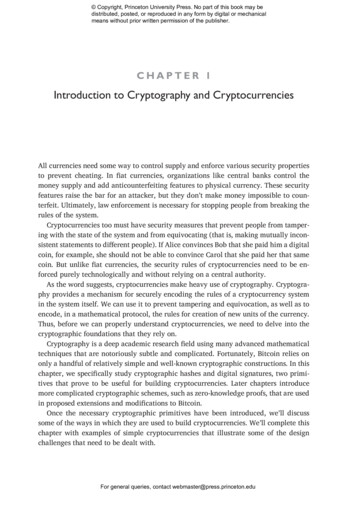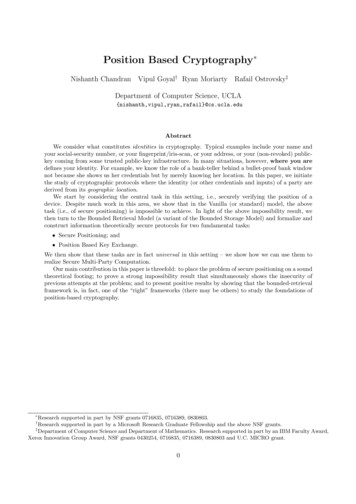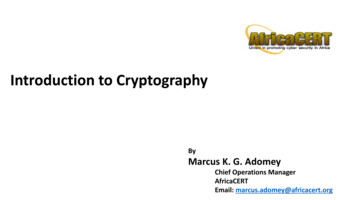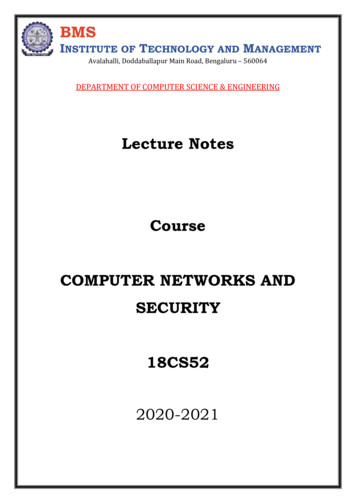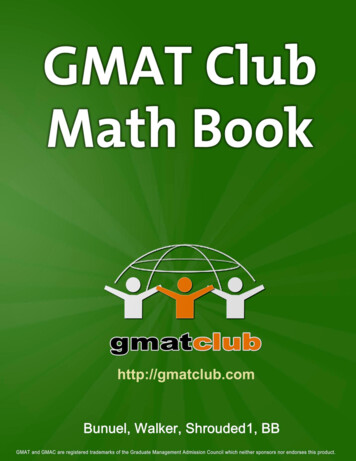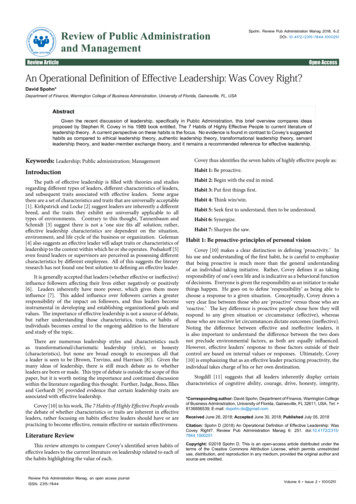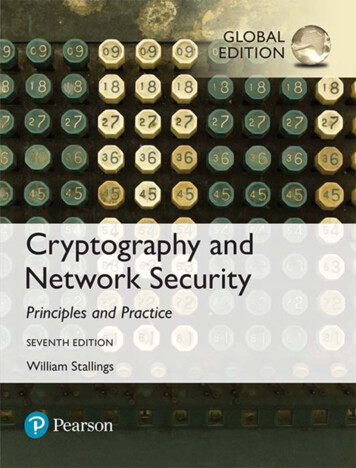
Transcription
NUMBER THEORY IN CRYPTOGRAPHYJASON JACOBSAbstract. In this paper, we will discuss some important cryptosystems. Thiswill involve proving why they work as well as discussing potential attacks onthem. Number theory is crucial to their existence, and this paper will beginby providing the necessary background in this field to be able to understandthe material.Contents1. Introduction2. Number Theory Background2.1. Basic Principles2.2. Definitions and Theorems to Know3. RSA Encryption3.1. Background3.2. Attacks4. Diffie-Helman Key Exchange4.1. Background4.2. Attacks5. Conclusion5.1. Final Notes6. AcknowledgmentsReferencesDate: August 28, 2021.11112446779991010
NUMBER THEORY IN CRYPTOGRAPHY11. IntroductionSending messages in secret has been necessary for thousands of years. If twoparties want to communicate without a third party knowing what they are saying,they must correspond in a fashion that the third party couldn’t understand evenif they saw the message. For example, if ally military leaders want to discusskey battle tactics, they cannot risk their foes intercepting and understanding theirmessages. This overall idea gave rise to the concept of cryptography. Individualswere enlisted to create ciphers in order to encrypt messages. One famous historicaltechnique is the Caesar Cipher, a primitive method of encryption named after JuliusCaesar. This is an example of a shift cipher, as its idea is to replace each letterwith a different letter by shifting the alphabet a specific number of places (e.g.“at” becomes “bu” if the alphabet is shifted by 1). If this was used for the Englishalphabet, obviously any number but a multiple of 26 would work (as this wouldshift a letter back to itself). However, since there are only 25 possible ways to shiftthe alphabet, this was easily broken by codebreakers. Even though more complexciphers of the same sort are possible, they are often easily broken by frequencyanalysis, a technique that uses the frequency of letters in words and attempts tomatch the most common symbols of the encrypted text to the most common lettersin the alphabet (e.g. a circle is the most common symbol in the intercepted messageand e is the most common letter in the English alphabet, therefore there is a solidchance that the circle represents e).Following this process, there has been a race between codemakers and codebreakers for many years. One wants to construct an indecipherable code, and the otherwill keep attempting to crack the cipher. As math advances, so do the differenttechniques used to construct ciphers. Overall, this paper will demonstrate thatnumber theory is a crucial component of cryptography by allowing a coherent wayof encrypting a message that is also challenging to decrypt. The discussion in thispaper follows the set of notes [1] [2] [3] by Evan Dummit.2. Number Theory Background2.1. Basic Principles. We must begin by explaining the math that is useful incryptography to allow for easier comprehension of specific cryptosystems.2.1.1. Divisibility and Prime Numbers. Prime numbers are an elementary part ofnumber theory that all readers must understand. First, consider all positive integersbesides 1, e.g. 2, 3, 4, etc. We can divide these numbers into two types: primenumbers and composite numbers. However, prior to going into the definition, wefirst need to explain the statement “a divides b.”Definition 2.1. For any two integers, we say that “a divides b” or “a b” if b isdivisible by a. In other words, a divides b if b ac for some integer c.Example 2.2. 4 12, since 12 4(3).Example 2.3. 8 56, since 56 8(7).Now, we can explore the idea of prime numbers and composite numbers.
2JASON JACOBSDefinition 2.4. An integer n 2 is prime if the only positive integers that dividen are 1 and n.Definition 2.5. An integer n is composite if more than two positive integers dividen.To clarify, every positive integer besides 1 is either prime or composite, as it willalways be divisible by at least 1 and itself.2.1.2. Modular Arithmetic. We will next discuss a part of number theory thathas played a role in a vast array of ciphers: modular arithmetic. To understandmodular arithmetic, picture a clock. The maximum number is 12, and no numberis larger than that. If one were to reference 5 hours after 12, they would not bereferencing 17, as there is no 17 on the clock. They would be talking about 5. Thisis the idea of modular arithmetic, and this is what we will call “modulo 12.”We define modular arithmetic formally as follows:Definition 2.6. We say that a b (mod m) if m divides a b.In arithmetic modulo (or “mod”) 12, all numbers are equivalent to some numberin the ranges 0-11 or 1-12. If we were speak about 20 hours after 6, we would notbe referring to 26, but instead be talking about 2. To reduce a large number to asmaller number modulo 12, we repeatedly subtract 12 from that number until wearrive at a number between 0 and 11. [1]Additionally, the following are some (but not all) arithmetic rules which stillapply:If a c (mod n) and b d (mod n), then a b c d (mod n) and ab cd(mod n).Example 2.7.(1) 10 is congruent to 2 modulo 4, because 10 2 8, whichis a multiple of 4.(2) 127 13 (mod 19), because 127 13 114 6 · 19.The Caesar Cipher from the introduction can be described more succinctly usingarithmetic modulo 26. If one wants to shift all letters by 3, then the easy way toaccomplish this is the following:(1) Convert all letters into numbers, with a being 0, b being 1, etc., with zeventually representing 25.(2) Add 3 to each number, ensuring that one uses modular arithmetic here.For instance, to encrypt c, one uses (2 3) mod 26 5 mod 26 5.(3) Convert each number back into a letter. Now, c is represented by f, y isrepresented by b, etc., and z is represented by c. We have our new alphabet.2.2. Definitions and Theorems to Know.2.2.1. Definitions and Theorems. We should also express the following definitionsand theorems before we begin to discuss cryptography.Definition 2.8. Two positive integers a and b are relatively prime if there doesnot exist a positive integer c greater than 1 such that c a and c b.
NUMBER THEORY IN CRYPTOGRAPHY3Theorem 2.9. Chinese Remainder Theorem: Let m1 , m2 , ., mk be relativelyprime positive integers such that the greatest common divisor of mi and mj is 1when i 6 j. Also let a1 , a2 , ., ak be arbitrary integers. Then there exists aninteger a such that the set of values x satisfying the equationsx a1(mod m1 )x a2(mod m2 ).x ak(mod mk )consists of those integers x congruent to a modulo m1 m2 .mk . Essentially, thissystem of equations has a unique solution modulo m1 m2 .mk .Proof. See [2]. Definition 2.10. We define ϕ(n) as the number of integers between 1 and n,inclusive, that are relatively prime to n. This function is known as Euler’s totientfunction.Example 2.11. ϕ(7) 6.The numbers between 1 and 7, inclusive, that are relatively prime to 7 are 1, 2, 3,4, 5, and 6. It is important to note here that 7 is prime and ϕ(7) 6, which is7 1. More generally, ϕ(p) p - 1 for every prime number p, as every number lessthan p shares no factors with p besides 1 and is thus relatively prime to p.Lemma 2.12. If N pq where p and p are prime numbers, then ϕ(N ) ϕ(p)·ϕ(q).Proof. By the definition, we know that ϕ(N ) will tell us the number of integersbetween 1 and N (inclusive) that are relatively prime to N . We also know thattwo integers are relatively prime if no positive integers greater than 1 divide bothof them. We can picture N as the prime number p which is then multiplied by theother prime q. As a result, N only has one more positive divisor than p (which isq), as q is only divided by 1 and itself. Therefore, only 4 numbers divide N : 1, p,q, and N .We can conceptually think about ϕ(N ) as follows: ϕ(N ) will not include p, q,and all the multiples of p and q up to and including N , as those will share a commonfactor with N (either p or q). There are precisely q multiples of p up to N , andthere are precisely p multiples of q up to N . Since we only multiplied p and qtogether once, there is no overlap except for N , which we double counted. Thus,ϕ(N ) N p q 1 pq p q 1 (p 1)(q 1) ϕ(p) · ϕ(q). Definition 2.13. The inverse of x modulo m is some number y that satisfies xy 1 (mod m). If x has an inverse modulo m, we say that x is a unit modulo m.Example 2.14. Suppose x 5 and m 19. Take y 4. Then, xy (5)(4) 20 1 (mod 19). Therefore, 5 is a unit modulo 19.Note that an inverse does not always exist. In fact, the inverse of a modulo monly exists if a is relatively prime to m.Definition 2.15. Suppose b is a unit modulo m. The order of b is the smallestinteger e 0 such that be 1 (mod m).
4JASON JACOBSExample 2.16. Consider b 2 and m 7.21 2, which is congruent to 2 mod 7.22 4, which is congruent to 4 mod 7.23 8, which is congruent to 1 mod 7.Thus, the order of 2 is 3.Definition 2.17. We say that a is a primitive root modulo m if a is a unit modulom and the order of a is ϕ(m).Example 2.18. Since 5 is prime, we know that ϕ(5) 5 1 4. Additionally, 3is a unit modulo 5 since 7 satisfies 3(7) 21 1 (mod 5). The order of 3 mod 5is 4, since 31 3 3 (mod 5), 32 9 4 mod 5, 33 27 2 (mod 5), 34 81 1 (mod 5). Thus, since 3 is a unit modulo 5 and the order of 3 is 4, which is ϕ(5),3 is a primitive root modulo 5.Theorem 2.19. Fermat’s Little Theorem: Suppose a is an integer. If p is prime,then ap 1 1 (mod p) if p is prime.Proof. See [2]. 3. RSA Encryption3.1. Background.3.1.1. Terms to Know.We are about to discuss one of the most popular and well-known cryptosystems:RSA encryption (this acronym originates from the last names of its creators). Thisis a method of encryption that originated in 1977 and is still used today. For example, RSA is used for digital signatures on documents [4]. Before explaining RSAencryption, we first need to establish a few terms that are necessary to understand.(1) Cryptosystem: A cryptosystem is a general term that describes the entireprocess for encrypting and decrypting a message.(2) Key: This is a “string of bits used by a cryptographic algorithm to transform plain text into cipher text or vice versa” [5]. For instance, if we wereto use a Caesar Cipher and shift all letters over 3 places in the alphabet,our key would be the number 3.(3) Alice, Bob, and Eve: The names of three hypothetical individuals used todescribe a situation involving a cryptosystem. Alice and Bob want to communicate in private, and Eve desires to intercept their message. Sometimesthe name Carol is also used if we depict a situation where three partieswant to communicate secretly.(4) Asymmetric versus Symmetric Cryptosystems: Asymmetric, or Public-Key,cryptography is when the key is not kept secret. Symmetric cryptographyis when the same key is used for encryption and decryption and thereforeshould only be known by Alice and Bob. For instance, if Alice and Bob wereto use a Caesar Cipher, that is an example of Symmetric cryptography, asif Eve knows the key, she will be able to decrypt any message that Aliceand Bob send to one another.3.1.2. Introduction to RSA Encryption.We are finally ready to proceed with learning about RSA Encryption. If Alicewants to send a secure message to Bob under RSA Encryption, they proceed as in[2]:
NUMBER THEORY IN CRYPTOGRAPHY5(1) Bob makes 3 choices:a) He picks some prime number pb) He picks some other prime number q, and computes N pq.c) He picks some positive integer e that is relatively prime to ϕ(N ).(2) Bob releases the values of N and e.(3) Alice writes her message and then converts it to some number m modulo Nby a process which she and Bob have previously discussed (not necessarilyin secret).(4) Using the formula c me mod N , Alice determines the value of c.(5) Alice sends the number c to Bob.(6) Bob receives the number c and needs to find m.(7) Bob finds an inverse d of e modulo ϕ(N ).(8) Bob finds m by computing cd (mod N ).We would like to clarify some parts of the process for the readers. First, e inpractice is often 3 and p and q are virtually always very large numbers. We aregoing to demonstrate the necessity of this shortly, but the reason why is security;if Eve is able to factor N , then she will have all the information that Bob possessesand will easily be able to decrypt Alice’s message. For this reason, RSA numbersare generally between 1024-2048 bits, which means often more than 21024 1 [6].Next, recall that ϕ(x) x 1 if x is prime. Additionally, we know from Lemma2.12 that if N pq with p and q being prime, then ϕ(N ) ϕ(p) · ϕ(q). Therefore,ϕ(N ) (p 1)(q 1). Also, remember that Bob releases the values of N and e; thisis why RSA is a public-key cryptosystem. We see that Alice, Eve, and everyoneelse can find out both N and e.Having described the process, we need to show why it works.3.1.3. Proof that RSA works. We need to prove that m cd (mod N ). Rememberthat m is the secret message, c me (mod N ), d is the inverse of e modulo ϕ(N ),and N pq (where p and q are two prime numbers). Additionally, remember thatd exists because e is relatively prime to ϕ(N ).We want to show that m cd (mod p) and m cd (mod q), since this will let usapply the Chinese Remainder Theorem to guarantee that m cd (mod N ). Keepin mind that the other condition for the Chinese Remainder Theorem to apply ismet: p and q are relatively prime because they are prime numbers. Therefore, ponly has 1 and p as its divisors, and q only has 1 and q as its divisors. Thus, theonly number that divides both p and q is 1, and therefore they are relatively prime.We are only going to show the p case for the sake of brevity, as the q case isvirtually identical (one just has to replace the “p”s with “q”s).It’s time to simplify some terms so we can see if the RSA decryption processworks. First, we will examine cd mod p.We know that c me (mod p). Therefore,cd (me )d med(mod p).Next, we can simplify d. We know that d is the inverse of e mod ϕ(N ). Thus, bythe definition of an inverse, d is the number that satisfies ed 1 (mod ϕ(N )). Thismeans that ed 1 kϕ(N ) for some k, hence ed 1 k(p 1)(q 1). In particular,00ed 1 k 0 (p 1) for k 0 k(q 1). Then, med m1 k (p 1) m · (mp 1 )k .Now, we will proceed to the crux of the proof. It centers around Fermat’s Little
6JASON JACOBSTheorem, which if we recall, states that if x is prime, thenax 1 1(mod x).0In the event that m 0 (mod p), then cd (m)(mp 1 )k 0 m (mod p),and we are done. In the more likely scenario that m 6 0 (mod p), then we needFermat’s Little Theorem. Since p (and also q, which is relevant for that case) is0prime, mp 1 1 (mod p). Therefore, cd (m)(mp 1 )k m (mod p), and we aredone.To stress once again, the same steps can be repeated to prove the q case.Since we have proven that m cd (mod p) and m cd (mod q),we can use the Chinese Remainder Theorem, which tells us that m cd (mod N).Thus, the RSA decryption process is mathematically legitimate. [2]3.1.4. Sample RSA Process. We are going to determine c and then determine mfrom c.Let m 25, N 187, and e 3. Bob chose 11 and 17 for his prime numbers,but Alice does not know that. Also, m and N would traditionally be significantlylarger, but this is for ease of understanding.To encode this, recall that Alice needs to determine c:c me (mod N ) 253 (mod 187) 15625(mod 187) 104.We are done encoding the message. Now, we are going to decode it. We need todetermine e mod ϕ(N ) 3 mod ((11-1)(17-1)) 3 mod ((10)(16)) 3 mod 160 3. Next, we need to find d. Remember that d is the inverse of 3, which is thenumber that satisfies d(3) 1 (mod 160). Since 160 3(53) 1, we can determinethat 3 · ( 53) 1 160 (mod 160), so 3 · ( 53) 1 (mod 160). Thus, d -53 mod160 107 .Lastly, we can compute m. Recall that m cd mod N , so m 104107 mod 187 25.As a whole, we can see why RSA is thought to be secure. It is extremely challenging to “undo” modular exponentiation, especially when the numbers becomelarge.3.2. Attacks.3.2.1. General. Suppose Eve has intercepted the message and knows Bob’s publickey. Therefore, she has the values N , e, and c, and now she has to solve for m. Shehas to figure out m from c me mod N .3.2.2. Factoring. One seemingly obvious yet necessary to mention method for trying to break RSA is factoring. If Eve is able to factor N and obtain p and q, thenshe can determine m in the same fashion that Bob does. Now, the question is ofcourse how Eve can factor N .The reader might assume that a brute-force attack could work, as there are obviously much fewer prime numbers than composite numbers. However, rememberthat N is an incredibly large number. It is effectively impossible for a human tostage a brute-force attack, and so it is irrelevant to discuss any further. Something more relevant and interesting for the future is a technological brute-forceattack. Computers could try and brute-force the solution significantly quicker thana human. Surprisingly enough, this is currently believed to be infeasible. Mathematicians speculate that an incredibly powerful computer can factor a 1048 bit
NUMBER THEORY IN CRYPTOGRAPHY7RSA key. Some RSA keys are of that length, but many are multiple times morethan 1048 bits and thus impossible to factor at the moment. [2]3.2.3. Hastad’s Attack. Hastad’s Attack is an excellent example of why e 3 shouldnot be used in some circumstances.Assume that e 3 and Alice sends a message to three different people with threedifferent public keys. These three keys are (N1 , 3), (N2 , 3), and (N3 , 3).Eve can then use the Chinese Remainder Theorem to break RSA encryption bysolving the following equations:C c1 (mod N1 )C c2 (mod N2 )C c3 (mod N3 )to find a residue C modulo N1 N2 N3 . Note that c1 , c2 , and c3 are the three differentencryptions.Remember that Eve knows all of those above numbers (besides C, obviously).Then, Eve knows that C m3 (mod N1 N2 N3 ). We know that 0 m N1 , N2 ,and N3 . Thus, 0 m3 N1 N2 N3 , and it also is the case that 0 C N1 N2 N3 .Since we know that C is congruent to m3 , it means that C m3 . Finally, sinceEve has solved for C and C m3 , Eve can determine m by taking the cube rootof C.The above applies only if N1 , N2 , and N3 are relatively prime, but if they aren’t,then the cryptosystem is quite easy to decrypt. Eve can just determine the greatestcommon divisor of two of the keys and thus receive a factorization of each. [2]What Hastad’s Attack overall demonstrates is that we should not send the samemessage to many different people if they are all using the same small value of e.4. Diffie-Helman Key Exchange4.1. Background.4.1.1. Introduction to Diffie-Helman Key Exchange. RSA encryption is arguablythe gold standard for modern-day cryptosystems [7]. Asymmetric encryption ismore logical than symmetric encryption, as Alice and Bob don’t need to worry aboutEve intercepting the key if they use the former method. For symmetric encryption,Eve finding out the key is disastrous and ruins the cryptosystem. However, thoughasymmetric encryption is obviously more secure, there is the issue of time. It takesquite a bit of time to both encrypt and decrypt long messages under an RSA system.As a result, symmetric encryption, while inferior, is the more practical approach.[3]However, the story luckily does not end here. There is a way to approach asymmetric levels of security while still maintaining efficiency. One can use an asymmetric system to agree on a key, and then use a symmetric cryptosystem to send amessage using this key. This makes a lot of sense, as it has many of the benefits ofasymmetric encryption but is still efficient, as the key is obviously a small message.This is effectively the idea of Diffie-Helman Key Exchange. It is a method fortwo parties to agree on a key in an asymmetric fashion, which they can then use toexchange messages with a symmetric cryptosystem. [3]
8JASON JACOBSWe will now proceed with showing how Diffie-Helman Key Exchange works. Hereis the process as articulated by [3], which is fairly straightforward yet extremelyeffective:(1) Alice and Bob publicly agree on two values: a prime number, p, and g, aprimitive root modulo p.(2) Alice privately picks an integer a.(3) Bob privately picks an integer b.(4) Alice computes g a mod p.(5) Bob computes g b mod p.(6) The two publicly send their results to each other.(7) Alice and Bob determine the key by taking g ab mod p, which just entailsraising the number they received from the other to the power of their individual number (a for Alice, b for Bob).Another useful property of Diffie-Helman Key Exchange is that it can includemore than two parties. For instance, assume that Alice and Bob want to includeCarol. The process is quite similar to the two-person process:(1) Alice, Bob, and Carol publicly agree on two values: p and g. Again, p is aprime number, and g is a primitive root modulo p.(2) Alice privately picks an integer a.(3) Bob privately picks an integer b.(4) Carol privately picks an integer c.(5) Alice computes g a mod p.(6) Bob computes g b mod p.(7) Carol computes g c mod p.(8) All of these results are made public.(9) Alice computes g ab mod p.(10) Alice computes g ac mod p.(11) Bob computes g bc mod p.(12) All of these numbers are made public.(13) Alice determines the key by taking g bc mod p and raising it to the powerof a.(14) Bob determines the key by taking g ac mod p and raising it to the power ofb.(15) Carol determines the key by taking g ab mod p and raising it to the powerof c.4.1.2. Sample Diffie-Helman Process. We are going to illustrate an example of usingDiffie-Helman Key Exchange. Alice and Bob decide that p 5 and g 3. Again,p would be larger in a real-world scenario. Remember from Example 2.18 that 3 isa primitive root modulo 5.Next, Alice picks a 2 and determines that g a (mod p) 32 (mod 5) 9 4(mod 5).At the same time, Bob picks b 4 and determines that g b (mod p) 34 (mod5) 81 1 (mod 5). Alice and Bob send these numbers to each other. Alicecomputes g ab (mod p) 44 (mod 5) 256 1 (mod 5). Bob computes g ab mod p 12 (mod 5) 1 1 (mod 5).Now, Alice and Bob both know that the key is 1. Notice that they both receivedthe same answer.
NUMBER THEORY IN CRYPTOGRAPHY94.1.3. Proof that Diffie-Helman Works. This proof is quite easy. Suppose thatthere are m people and person n (where n m) needs to find the key. They havereceived g a1 a2 .an 1 an 1 .am , and raising that number to the power of an will yieldg a1 a2 .an 1 an an 1 .am (which they reduce mod p) and therefore the secret key. Thisis considered to be a secure form of encryption, as a and b are kept private andfiguring them out is extremely challenging.4.2. Attacks.4.2.1. General. Again, recall the information that Eve possesses. She has all of thepublic values, which includes g, g a , g b , g ab , etc. She needs to determine the valueof g abc. to obtain the key. [3]4.2.2. Discrete logarithm computation. First, we need to begin with a definition.Definition 4.1. If b is a unit modulo m and a is another unit with a bd (modm), we say that d is the discrete logarithm of a modulo m to the base b and writed logb (a).This is a fairly straightforward attack, but it is one of the most mathematicaland therefore beneficial to include. Remember from above that Eve has g and everyvalue when it is raised to some exponent. Therefore, Eve could attempt to calculatelogg (g a ) to figure out a. From that, Eve can simply take her known value of g b andraise it to the power of a. [3]Again, this seems fairly simple, but it is virtually impossible absent incrediblypowerful technology. This is also another attack that demonstrates the value of using large numbers; if p is extremely large, then this attack becomes nigh impossibleto execute. [3]5. Conclusion5.1. Final Notes. As a whole, number theory and cryptography are closely related. As number theory has advanced, so has the security of cryptosystems. Inthis paper, we examined two techniques that are well-known and important in thefield of cryptography. Both RSA encryption and Diffie-Helman Key Exchange arestill used and the former is extraordinarily popular, but they are relatively old. Inthis field, the rapid development of technology means that constant attacks are being staged on cryptosystems. As a result, cryptologists are looking for new ideas todeliver secret messages. One more modern example is elliptic curve cryptography,which has a similar premise to RSA and Diffie-Helman. The idea is that these areall probably solvable with powerful enough technology and infinite time, but theyare virtually impossible to solve in any reasonable amount of time with our currenttechnology. Elliptic curve cryptography centers around the idea that calculatingdiscrete logarithms on elliptic curves is very difficult with modern technology, andthus it is extremely interesting for the future of cryptography. Long-term, cryptologists are considering post-quantum methods of encrypting messages. Since theadvent of quantum computers may spell doom for modern cryptosystems, cryptologists need to find new techniques. It is unclear exactly how this will work, butit is certain that math will be crucial. Nonetheless, cryptography is a fascinatingfield and the main way in which number theory has proven to be extremely useful
10JASON JACOBSoutside of inherent academic purposes. Technology will continue to advance and attack complex mathematical problems, but mathematicians will continue to explorethe outer reaches of their field and invent new ways of encoding messages.6. AcknowledgmentsI would like to thank my brother, parents, and grandparents for always beingthere for me and being the main reasons why I was fortunate enough to receivethe opportunity to attend the University of Chicago and its Mathematics REU.Additionally, I would like to thank Sam Quinn for being an excellent mentor. Thispaper would not be nearly what it is without his guidance, and I sincerely appreciateall that he has done to enrich my REU experience. Lastly, I would like to thankProfessor May for hosting the REU and ensuring that it is a great program.References[1] Evan Dummit. Cryptography (part 1): Classical Cryptosystems and Modular Arithmetic.Northeastern University, 2016. Located online at: phy 1 classical cryptosystems.pdf.[2] Evan Dummit. Cryptography (part 2): Public-Key Cryptography. Northeastern University, 2016. Located online at: phy2 public key cryptography.pdf.[3] Evan Dummit. Cryptography (part 3): Discrete Logarithms in Cryptography Northeastern University, 2016. Located online at: phy 3 discrete logarithms in cryptography.pdf.[4] Kenneth Levasseur. Digital Signatures using RSA. University of Massachusetts Lowell,2013. Located online at: https://faculty.uml.edu//klevasseur/math/RSA Signatures/RSASignatures.pdf.[5] Cryptographic Key. techopedia. Located online ptographic-key.[6] algorithm/.[7] Israel Koren. Fault-Tolerant Systems, 2nd Edition. University of Massachusetts Amherst,2020. Located online at: stems/simulator/RSA/new page 5.htm.
number theory is a crucial component of cryptography by allowing a coherent way of encrypting a message that is also challenging to decrypt. The discussion in this paper follows the set of notes [1] [2] [3] by Evan Dummit. 2. Number Theory Background 2.1. Basic Principle
